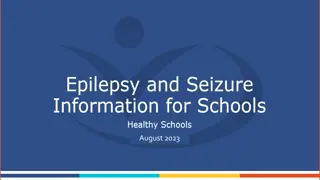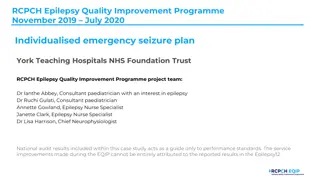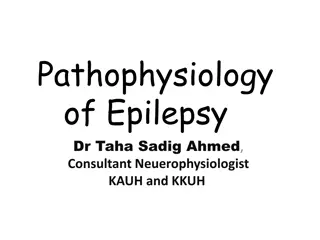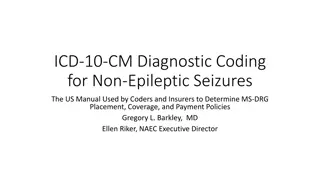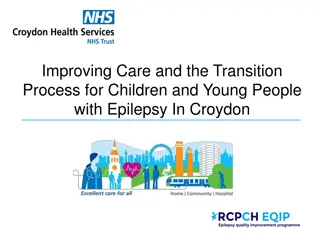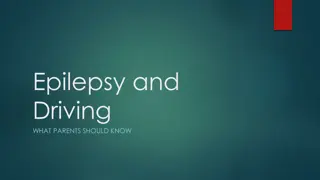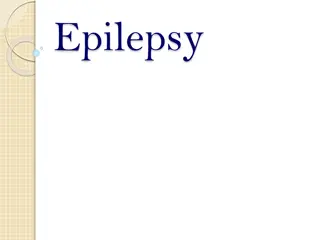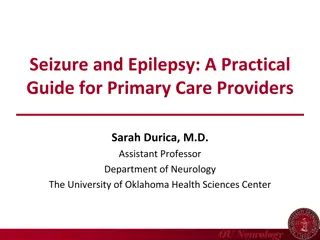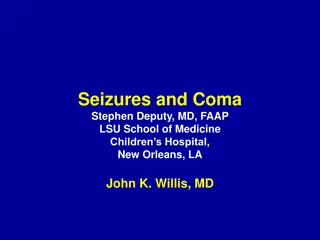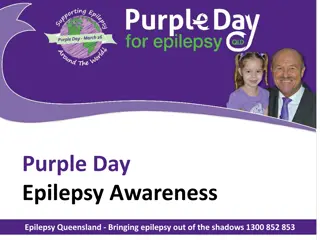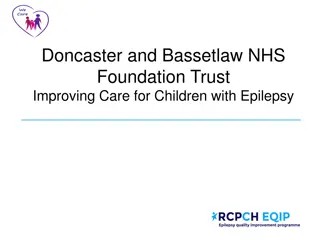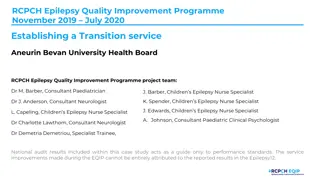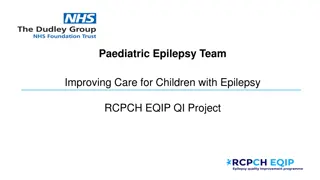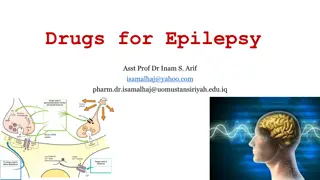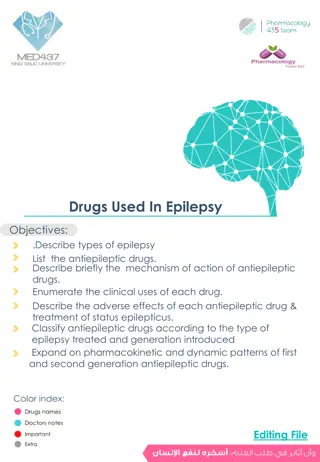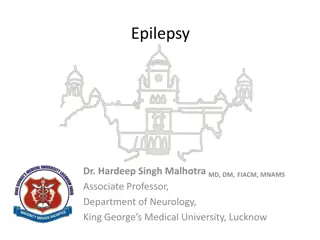
Understanding Epilepsy: Symptoms, Causes, and Management
Learn about epilepsy, a neurological disorder characterized by recurrent seizures. Discover the different types of epilepsy, its prevalence in Australia, and common causes. Find out how to manage epilepsy and provide first aid for seizures.
Download Presentation

Please find below an Image/Link to download the presentation.
The content on the website is provided AS IS for your information and personal use only. It may not be sold, licensed, or shared on other websites without obtaining consent from the author. If you encounter any issues during the download, it is possible that the publisher has removed the file from their server.
You are allowed to download the files provided on this website for personal or commercial use, subject to the condition that they are used lawfully. All files are the property of their respective owners.
The content on the website is provided AS IS for your information and personal use only. It may not be sold, licensed, or shared on other websites without obtaining consent from the author.
E N D
Presentation Transcript
I would like to acknowledge the peoples who are the Traditional Custodians of the Land. I would also like to pay respect to their Elders both past and present and extend that respect to other Indigenous Australians who are present .
What are we going to learn in this presentation? What epilepsy is? What seizure is? What a seizure looks like? The difference between them? Causes of Epilepsy. Seizures groups 3 Groups of seizures explained with images Strategies to manage Epilepsy Seizures and Injury First Aid for Epilepsy Epilepsy Awareness Day Need to know Facts and Statistics about Epilepsy
What is epilepsy? Epilepsy isn't one disease or condition. There are many kinds of epilepsy with different symptoms and patterns. It's important to know what kind you have. Epilepsy is a common disease of the brain where there is a tendency to have recurrent seizures. It is a neurological disorder not a form of mental illness and seizures are caused by a temporary disruption of the electrical activity in the brain.
Approximately 3% to 3.5% of Australians will experience epilepsy at some point in their lives and over 250,000 Australians currently live with epilepsy. Epilepsy can start at any age although it is more likely to be diagnosed in childhood or senior approximately 40% of the population with epilepsy. There are many different types of epilepsies and people s experiences differ greatly. Some types of epilepsy last for a limited time and the person eventually stops having seizures. For others, epilepsy is a life-long condition. However more than two thirds of people with epilepsy become seizure free with medication. years. Children represent
The cause of epilepsy can be identified in about half of people with epilepsy, but the remaining half never find out why they have epilepsy. Some known causes of epilepsy include: head injury such as in a car accident, trauma or serious fall Stroke or brain haemorrhage
Brain abnormalities or malformations Brain tumours Genetic factors Degenerative conditions affecting the brain (such as dementia). Lack of oxygen to the brain for a prolonged period (such as in birth trauma, cardiac arrest, drowning, drug overdose) Brain infections (for example meningitis, encephalitis or brain abscess).
Seizure classification is a way of naming the many different types of epileptic seizures and putting them into groups. Doctors look at the following three things when classifying a seizure: Where in the brain the seizure starts (e.g. the onset) If the person is aware or not during the seizure Whether the seizure involves movement.
Seizures can be divided into three major groups: Focal Onset Generalised Onset Unknown Onset
Seizures are different for each person. It depends on which part of the brain the seizure occurs in and what functions that part of the brain controls. Some seizure features include: A person's body stiffening and falling to the ground, followed by strong, symmetrical, rhythmic movements (tonic-clonic) Loss or disturbance of awareness ( absence , blackout spells), blank stare Feelings of d j vu or an unpleasant smell or taste Confusion, disorientation A fall, sometimes with no memory of the fall Involuntary movement twitching or abnormal sensory disturbance of limb/s or face without a loss of consciousness Automatisms repetitive, automatic trance-like movements (e.g. fiddling with clothes, repeated use of strange words or repeated swallowing) Sleep disturbances, restlessness, inability to maintain a regular REM sleeping pattern Loss of bladder or bowel control.
Reducing the number of seizures a person is having will help to lessen the risk of seizure-related injury or death. See the doctor Have annual reviews with epilepsy specialist . Ask questions about how to best manage seizures. Be honest with your doctor so your treatment can be adjusted if needed. Getting right medication.
Knowing & avoiding triggers Sometimes a person may be aware that specific events or circumstances are more likely to cause seizures. These are usually called seizure triggers, and recognising these triggers can help you to reduce or even avoid seizures. Triggers may include lack of sleep, stress, physical fatigue, missing medication, alcohol or poor health. There are more individualised triggers for some people. Seizures can also be triggered by rapid changes in medication, changing to a new medication or if you forget to take your medication. Understanding your triggers can help control of your seizures and help keep yourself safer. Keeping a seizure diary can help with identifying seizure triggers.
Seizures and blackouts affect consciousness, awareness and judgement, which can increase the risk of accidents and injury. When someone you know is diagnosed with epilepsy, think about what things around safety may affect you and the clients. When you are diagnosed with epilepsy think about what things around safety that may affect you. This could include driving, using heavy machinery, working at heights, around water, sports, recreation and general safety issues.
What can I do to reduce the risk of incidents or injury? Take some time to think about your work environment, and lifestyle or recreational activities for possible risks. Ask yourself: What risks are there for anyone in this setting? What are the potential hazards if I had a seizure? What actions can I take to reduce the risk of harm to myself or others? Identifying and planning ahead to reduce risk can help you to pursue your day to day activities as safely as possible.
People with epilepsy do not always know when a seizure may happen, which can make them particularly vulnerable in some situations. It makes a difference when people around you know how to help if a seizure occurs. If someone has a seizure: check for medical ID, care plan or emergency contact details on them If safe to do so, check to see if they have this information. Discuss your seizures with your doctor or epilepsy nurse and explore alarm / monitoring device options. These cannot guarantee safety 100% but can give you or your family more peace of mind. They may be helpful to as part of a wider care plan, but they should not be relied on as the only method for reducing risks.
There are many different seizure types and seizure syndromes. Epilepsy is not just one condition; there are many forms of epilepsy. Epilepsy in not contagious. Many people with epilepsy still say the biggest problem they face is dealing with the attitude of others. Ignorance, stigma, discrimination and fear are still major problems. Terminology and labels to be avoided that may help reduce stigma: Illness - epilepsy is a neurological condition, not an illness. Disorder -epilepsy is a disease, not a disorder. Fit - the term seizure is preferred. There are many different types of seizures. A convulsion is a term for a seizure involving stiffening and jerking of the body. Fit implies wilful outbursts, like a tantrum , or loss of emotional control. Victim or sufferer this implies someone who is helpless. Most people with epilepsy want your understanding, but not your pity.
What is Purple Day? Purple Day (26th March) is a global initiative dedicated to raising epilepsy awareness. Purple Day was founded in 2008, by nine- year-old Cassidy Megan of Nova Scotia, Canada. Motivated by her own struggles with epilepsy, Cassidy started Purple Day in an effort to get people talking about the condition and to let those impacted by seizures know that they are not alone. She named the day Purple Day after the internationally recognised colour for epilepsy, lavender.
Caring for someone can be a real joy. And it can be really demanding. Among other things it can be hard to: Get the information you need about the person you re looking after Get service providers to take your role seriously and involve you in information and decisions Have enough time and energy to find places of possible support for yourself for when you have witnessed a seizure happening. Stay healthy enough in mind and body to continue being the best carer you can be.
What epilepsy is What seizure is The difference between them. Causes of Epilepsy Seizures groups What a seizure looks like. 3 Groups of seizures explained with images Strategies to manage Epilepsy Seizures and Injury First Aid for Epilepsy Epilepsy Awareness Day Need to know Facts and Statistics about Epilepsy How to look after ourselves as carers for clients with Epilepsy
What do you know about Epilepsy? Have you ever encountered someone having a seizure? Do you know what to do when you witness someone having a seizure? List some ways in which you can manage epilepsy with your clients? Can you explain first aid procedure for seizures.

